How to configure a Delta-style English oto.ini
This is based on Delta's official guide for configuring Delta-style English banks. It will cover how to create a base oto and how to properly configure each alias. While not a direct translation of the original, all the information should be correct. If you're familiar with Delta ENG and notice issues, let me know.
This guide assumes you already know how to oto Japanese CVVC. Delta's "official" CVVC oto guide can be found here (in English); you might want to read it even if you can oto CVVC.
If you are stuck on otoing anything shown here and want examples, Teto English is a good starting point; her reclist is very similar to List #3, which has everything you might need examples for.
The information provided here will also give some insight on otoing voicebanks using Peiton Macaron's reclist, as it's derived from Delta EN, but you will probably get more relevant information looking at VCCV or ARPASING guides (this does not explain how to oto [- C]/[C -] aliases or other things added to Peiton English).
This guide was assembled by PSP, and cannot be reprinted without permission. Please link to this page instead.
Contents
Necessary tools
Download "doub_alias" and "mkototemp" here, under the 補助ツール section.
Creating a base oto
Download the Delta reclist here (Click "Number #" for your preferred reclist)
The zip will come with mkototemp.ini, dubalias.ini, and presamp.ini files.
↓
Record samples (I recommend using a 4-beat BGM like Salem's or the VCCV English one)
↓
Put the mkototemp.ini file from the reclist zip next to mkototemp.exe.
Modify the [TEMPO] and [OFFSET] parameters in mkototemp.ini to match your recordings. [OFFSET] is measured in milliseconds. Drag and drop the reclist you recorded with onto mkototemp.exe.
It is important to note that depending on the reclist, you may need to create "h-" aliases by hand.
For example, if you input the lyrics [ask][him], the sound will drop because there is no alias for [k hi] in the oto.
Everything else should be fine. (Personal testing: when recording List #3 i had to create most [V h-] aliases by hand while otoing. It should be obvious if things are missing.)
↓
Base oto is created
↓
Put the dubalias.ini file from the reclist zip next to dubalias.exe. Drag and drop the generated oto.ini onto dubalias.exe. (This step is similar to setparam's option "Substitute お for を if not recorded".)
The specific duplicated aliases are:
3 [C]→r [C]- Makes
Esynonymous withe - Makes CVs with
oUin them synonymous witho - Makes CVs with
aIoraUin them synonymous witha
(After personal testing, it might be best to use dubalias after otoing the base list, and then checking the new aliases to see if any changes should be made. Either will be fine, though.)
(Also, if you recorded a list that has VV strings in it, make sure to oto the diphthongs as instructed below.
Configuring CV/CCV + diphthongs
[CV] and [- CV] are configured the same as in Japanese CVVC.
However, diphthongs (eI, aI, aU, OI, oU) need to be handled a bit differently.
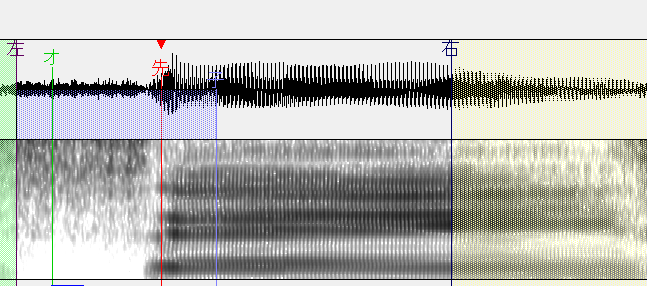
[seI]
Left blank: Start of consonant sound (same as CV)
Overlap: ⅓ of the preutterance (same as CV)
Preutterance: Start of the vowel sound (same as CV)
Consonant: Up until the vowel is stable (same as CV)
Right blank: Placed before the second vowel sound begins
For example, when configuring seI, you should only hear se.
If you can hear the I sound, it's been configured incorrectly.
Because of this, when a phrase ends with a diphthong, like [seI], the I sound will be missing.
Therefore, be sure to use the proper ending sound, like [seI][eI-].
Configuring VC/VVC + diphthongs
[VC]s are configured the same as in Japanese CVVC.
However, diphthongs (eI, aI, aU, OI, oU) need to be handled a bit differently.
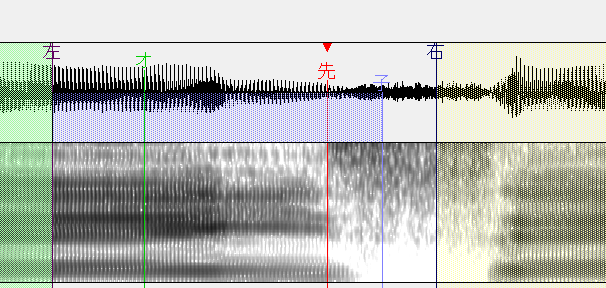
[eI s]
Left blank: Where the first vowel sound is stable
Overlap: Where the first vowel sound is stable
Preutterance: Start of the consonant sound (same as VC). Ideally should be 3× the overlap value
Consonant: Where the consonant is stable (same as VC)
Right blank: Where the consonant is stable (same as VC)
The first vowel (e here) should be surrounded by the left blank and overlap.
Configuring V C-, VV C-, V CC-
Used in phrases that end with a consonant.
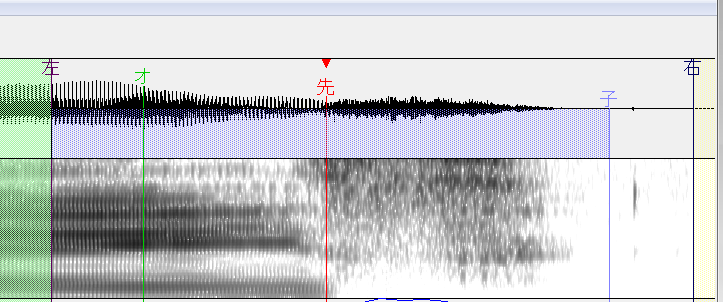
[E s-]
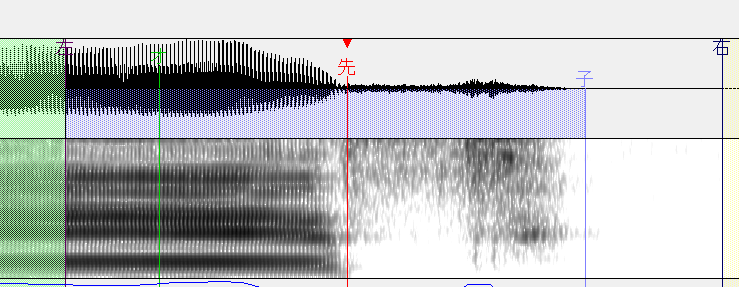
[eI s-]
The left blank, overlap, and preutterance are handled the same as VC/VVC.
Consonant: Immediately after the last consonant sound
Right blank: Silence
By the way, the area referenced by presamp for note length is the length between the preutterance and the consonant.
Configuring onset consonant clusters
Onset consonant clusters are 2~3 consonants at the start of a word (i.e. "st" in star, "spr" in spring).
Since recording [CCV] and [CCCV] samples makes the reclist very, very long, Delta reclist #2 and beyond uses [- CC] and [CC] aliases instead.
Two consonants (when the second consonant is a plosive)
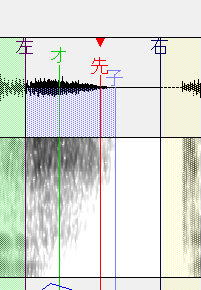
[s t]
Left blank: Start of the s sound
Overlap: ⅓ of the preutterance (Same as s CVs like [si] or [seI])
Preutterance: Start of silence
Consonant: Somewhere in silence (Same as t VCs like [E t] or [oU t])
Right blank: Somewhere in silence (Same as t VCs)
Two consonants (when the second consonant is not a plosive)
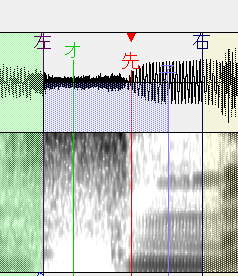
[s m]
Left blank: Start of the s sound
Overlap: ⅓ of the preutterance (Same as s CVs like [si] or [seI])
Preutterance: Start of the m sound
Consonant: Stable part of the m sound (Same as m VCs like [E m] or [oU m])
Right blank: Stable part of the m sound (Same as m VCs)
Three consonants
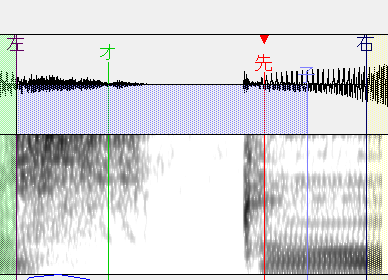
[stw]
Left blank: Start of the s sound
Overlap: ⅓ of the preutterance (Same as s CVs like [si] or [seI])
Preutterance: Start of the w sound
Consonant: Stable part of the w sound (Same as w VCs like [E w] or [oU w])
Right blank: Right before the vowel starts (Same as w VCs)
Configuring onset CCV
How to configure onset consonant clusters like [CCV] and [CCCV].
These are only used when configuring banks recorded with Delta English lists #1 or #0.

[stw@]
Left blank: Start of the first consonant
Overlap: Stable part of the first consonant
Preutterance: Start of the vowel
Consonant: Stable part of the vowel
Right blank: Stable part of the vowel
The gap between the overlap and the preutterance will likely be larger than usual, but it may be better to keep the overlap to ⅓ of the first consonant.
Configuring coda consonant clusters
Coda consonant clusters are a string of consonants at the end of a word (i.e. "rm" in arm, "dnt" in didn't, "skt" in asked)
Since recording [V CC-] and [V CCC-] samples makes the reclist double in length, Delta reclist #1 and beyond uses [C C-] and [C CC-] aliases instead.
For list #0, [V CC-] and [V CCC-] are configured the same way as [VC].
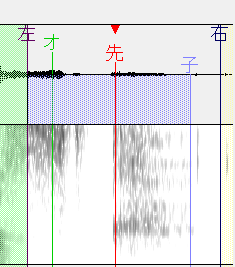
[s k-]
Left blank, overlap: Surround the steady part of the s sound
Preutterance: Start of the second consonant
Consonant, right blank: Surround silence
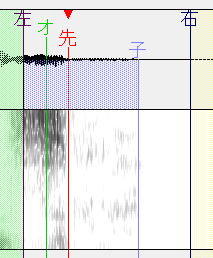
[z m-]
Left blank, overlap: Surround the steady part of the z sound
Preutterance: Start of the second consonant
Consonant, right blank: Surround silence
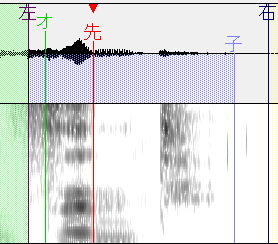
[z nt-]
Left blank, overlap: Surround the steady part of the z sound
Preutterance: Start of the second consonant
Consonant, right blank: Surround silence